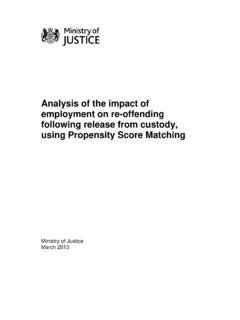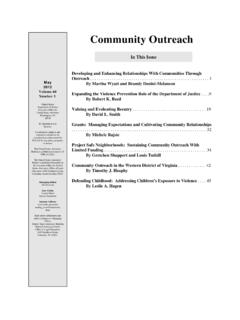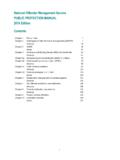Transcription of Transforming Rehabilitation: a summary of evidence on ...
1 Transforming Rehabilitation: a summary of evidence on reducing reoffending Ministry of Justice Analytical Series 2013. Analytical Services exists to improve policy making, decision taking and practice by the Ministry of Justice. It does this by providing robust, timely and relevant data and advice drawn from research and analysis undertaken by the department's analysts and by the wider research community. Disclaimer The views expressed are those of the authors and are not necessarily shared by the Ministry of Justice (nor do they represent Government policy).
2 First published 2013. Crown copyright 2013. You may reuse this information (excluding logos) free of charge in any format or medium, under the terms of the Open Government Licence. To view this licence, visit or email Where we have identified any third party copyright material, you will need to obtain permission from the copyright holders concerned. Any enquiries regarding this publication should be sent to us at This publication is available for download at and-analysis/moj ISBN 978-1-84099-608-1. Acknowledgements The Ministry of Justice would like to thank the two anonymous peer reviewers for their comments on this report.
3 Ministerial foreword For too long, reoffending rates have remained stubbornly high, particularly among short sentence prisoners. This Government is absolutely committed to addressing this problem. This is why, on 9 May, we published Transforming Rehabilitation: A Strategy for Reform. This document sets out the Government's plans for Transforming the way in which offenders are managed in the community in order to bring down reoffending rates. For the first time in recent history, every offender released from custody will receive statutory supervision and rehabilitation in the community.
4 We want to make sure that all those who break the law are not only punished, but also engage in rehabilitation. Our reforms will put in place a system that encourages innovation to improve outcomes. We are introducing new payment incentives for market providers to focus relentlessly on reforming offenders, giving providers flexibility to do what works and freedom from bureaucracy, but only paying them in full for real reductions in reoffending . Using evidence to inform service delivery is not necessarily a straightforward matter, and is certainly not a simple case of selecting from a menu of options.
5 We know that for some interventions the evidence on effectiveness is strong, with convincing evidence of the impact on reoffending levels. For other interventions, evidence is only just emerging, or it is very weak; this may be because the interventions are new, under-researched or difficult to research (for instance, because of their complexity). This should not hold us back from trying to improve the quality of our services. There is no excuse for not seeking to reduce reoffending rates, to turn lives around and achieve improved rehabilitation outcomes.
6 In those cases where there is no clear evidence about effectiveness, that should not prevent us from considering new approaches. In the absence of decisive evidence , partners will want to have a sound theoretical rationale for their approaches, and will want to draw on the extensive insight and learning offered from a range of different research types, both qualitative and quantitative, to inform their thinking. Expertise, whether scientific or operational, will inform the best approaches. We should be using the best available evidence and the best thinking, the best minds to take well-informed decisions about the most effective and efficient approaches to take, to support innovation and improve rehabilitation outcomes.
7 To support organisations working with offenders, we have also launched the pilot Justice Data Lab. This new service will support organisations, in particular the voluntary, community and social enterprise sector, to understand their specific impact on reducing reoffending . We will also be publishing the results from the Justice Data Lab, enabling all those working with offenders to see clearly what works and to help create a culture of best practice and transparency. Taken together, these diverse sources of information, data and evidence will support the day-to-day work of ensuring the right individuals receive the right interventions, and that sentences are implemented in the best possible way and to best effect.
8 We look forward to continuing to work with providers of rehabilitative services to improve outcomes, reduce reoffending , and improve and build the evidence base for the future. Jeremy Wright Contents List of tables 1. Introduction 1. Purpose of this evidence summary 1. Structure of the document 2. 2. reoffending and desistance 3. Measures of reoffending 3. Factors which influence reoffending 3. Desistance 7. Understanding different offender populations 9. 3. Working effectively with offenders 10. Skilled supervision 10. Addressing offender needs in a holistic and sequenced manner 11.
9 Integrated offender management and multi-agency partnership 11. Quality 11. 4. evidence on reducing reoffending 13. Scope and quality of evaluation evidence on reoffending 13. Addressing drug misuse 16. Addressing alcohol misuse 17. Addressing accommodation needs 18. Addressing employment needs 19. Addressing mental health problems 20. Offending behaviour programmes 21. Developing and enhancing family relationships 24. Addressing negative peer relationships 25. Restorative justice conferencing 25. Mentoring 26. 5. Conclusions 28. Annex A 29. Further information on links to reoffending 29.
10 Annex B 30. Sources on data and research evidence on offenders and reoffending 30. Annex C 34. Prevalence of factors commonly associated with reoffending 34. Annex D 37. Standards of evidence 37. Annex E 40. Commissioned and co-commissioned services 40. Annex F 42. Interim findings from payment by results pilots at Peterborough and Doncaster prisons 42. End notes 44. List of tables Table : Dynamic factors commonly associated with reoffending 5. Table : What helps individuals desist from crime? 8. Table : Evaluations of effectiveness in reducing reoffending 15.













